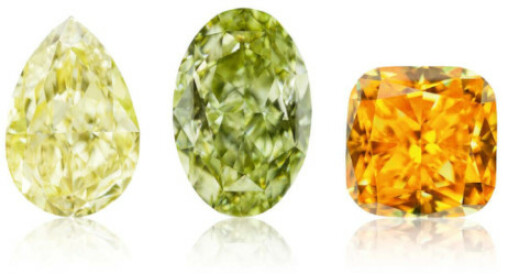Our A to Z series on Natural Fancy Coloured Diamonds has come to an end
|
 |
| In this Issue: |
 |
|
|
|
Dear Customers, Dear Friends of Our Natural Fancy Coloured Diamonds
Welcome to our summer newsletter!
We hope that you have been able to catch a few rays of sunshine and enjoy the summer in peace.
In this newsletter, we will bring our "Fancy ABCs" to an end, but don’t worry, a downloadable PDF with the entire "Fancy ABCs" series is available on our homepage under News.
We would also like to provide you with some interesting information on our popular Natural Fancy Coloured Diamonds for your upcoming autumn season. As a matter of fact, we were recently in Antwerp again and brought back new, inspiring treasures!
|
 |
Enjoy your reading and browsing!
Your teams from Kulsen & Hennig GbR and Dominik Kulsen AG
Juliane Hennig
|
|
T - Top Light Brown (TLB)
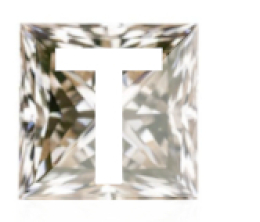 |
Champagne coloured diamonds are always a classic among Natural Fancy Coloured Diamonds and are extremely versatile. When trying to describe the various shades of these diamonds, some imaginative comparisons come to mind, including everything from honey to cinnamon and caramel, to cognac and chocolate.
|
To facilitate dealings with champagne-coloured diamonds, the now-closed Argyle mine developed a system called The Champagne Coloured Diamond Colour Scale. The colour scale consists of seven grades, ranging from C1 (light champagne) to C7 (dark cognac).
But what about diamonds that are lighter than C1/C2? Technically, these stones are considered colourless diamonds.
As a reminder, the grading scale for colourless diamonds ranges from the top quality colour "D" (colourless) to the visibly tinted shade "Z". |
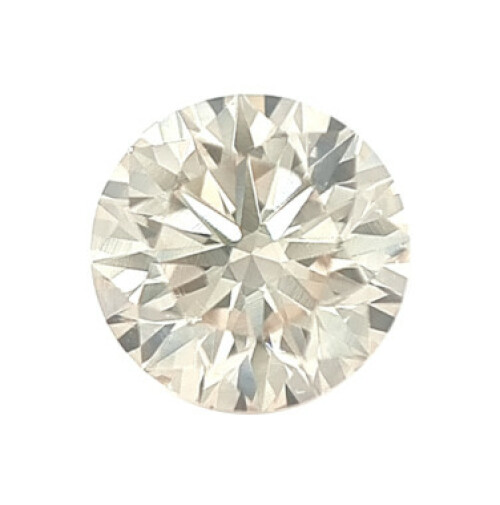 |
Diamonds that are lighter than C1/C2 but still possess a recognisable colour are assigned letter grades from K to Z according to the officially recognised GIA colour scale for colourless diamonds.
Faint Brown : letters K to M
Very Light Brown : letters N to R
Light Brown : letters S to Z
In addition to this colour scale, diamonds within these colour designations are also often referred to in international trade as Off White Light Brown (OWLB), Top Top Light Brown (TTLB) and Top Light Brown (TLB).
The special advantage of the colours Top Top Light Brown and Top Light Brown is that they are very subtle, yet elegant. Especially when set in red, rose, or yellow gold, these colours ensure that a particularly soft and harmonious contrast is created between the precious metal and the diamond.
Note: Although the colours of diamonds are evaluated in a laboratory with technical aids and with comparison stones, in the end, the human eye decides which colour grade a given stone receives. The nuances are so subtle that there may well be small overlaps or differences in colour perception. Even when viewed "at home", different colour impressions can occur depending on the light and the type the day.
|
|
U - UV Light and Diamonds
 |
UV light stands for ultraviolet light and is a type of electromagnetic radiation that is invisible to the human eye and that has a higher energy than visible light.
UV light is emitted by the sun and can also be produced by artificial light sources, such as UV lamps.
|
What Does This Have to Do with Diamonds?
Some gemstones (including diamonds) can fluoresce under UV light, which means that they show a different colour or brightness under UV light than under normal light. Diamonds, for example, often glow blue under UV light, but other colours such as yellow, green or violet can also occur.
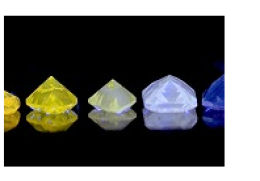 |
Notes on fluorescence in coloured diamonds:
Chameleon diamonds all have high fluorescence.
With yellow diamonds, for example, a yellow fluorescence can actually enhance the stone's colour, making it appear more intense. |
Fluorescence occurs when gemstones contain certain chemical elements or impurities that react to UV radiation. When UV light hits the stone, some of the light's energy is absorbed by the atoms in the gemstone and re-emitted in the form of visible light. This causes the gemstone to show a different colour under UV light than under normal light. The type and intensity of fluorescence depends on the type of gemstone and the type of impurities. Some gemstones fluoresce very strongly under UV light, while others show only weak fluorescence or do not fluoresce at all.
Examples of Diamonds with Different Degrees of Fluorescence:
Photo: essiluxgroup.com
Photo: gia.edu
|
|
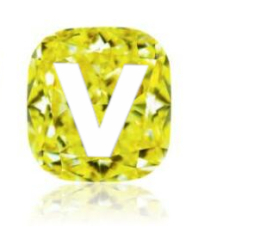 |
Reminder: Natural Fancy Coloured Diamonds occur in nature in a wide variety of colours.
The colour of a Natural Fancy Coloured Diamond is described, on the one hand, by the hue and, on the other hand, by the colour intensity. |
The hue describes the property by which one distinguishes colour sensations such as Fancy Pink, Fancy Yellow, or Fancy Green.
The intensity level of the colour can range from very light to very strong. The stronger the intensity, the higher the value of the diamond.
The GIA has developed an intensity grading scale for this purpose to categorise the intensity grades:
Delicately coloured diamonds that fall under the following three categories still count as colourless diamonds, as the colour is quite faint and can only be seen on closer inspection:
Weak (Faint)
Very Light
Light
From this point on, diamonds are considered "coloured" because the colour is visible at a glance and have earned the prefix "Fancy":
Fancy Light
Fancy
Fancy Intense
Fancy Deep or Fancy Dark
Fancy Vivid
Colour Intensities Using the Example of Yellow Diamonds:
The term "Fancy Vivid" describes the highest degree of colour intensity that diamonds can have, meaning the colour is brilliant, bright, and vibrant. Diamonds with this colour designation are particularly rare and correspondingly valuable. The colour of such a diamond is unmistakable. It doesn't get any better than that!
|
|
W - White Doesn't Mean Colourless
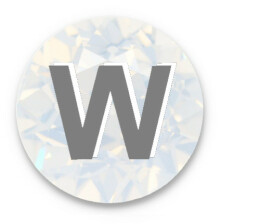 |
White diamonds are beautiful, almost opaque diamonds that have a milky appearance. Because of this feature, they are often called "Milky Diamonds" in the trade. Unfortunately, the term "white diamonds" is often mistakenly used for transparent, colourless diamonds, but this is not correct. White diamonds are milky white, while the classic colourless diamonds show no colour at all. |
In other coloured diamonds, the colour is caused by trace elements, such as nitrogen or boron, but the colour in white diamonds (i.e., "milky diamonds") is caused by a high number of tiny inclusions that scatter the light. So, in fact, white diamonds are basically colourless diamonds with many, many, very small inclusions that create their typical frosty, "milky" white colour.
Since white is not actually a colour, however, these diamonds are not judged by their degree of saturation like their coloured siblings but are always referred to as "Fancy White". |
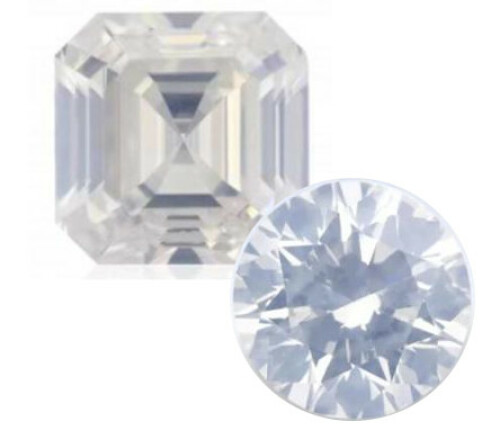 |
|
|
X to Z - Not Quite "Fancy"
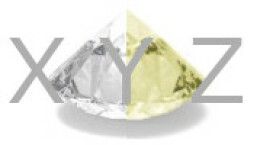 |
Colourless diamonds do not always have the same colour quality and intensity. Within the category of colourless diamonds, stones can range in colour from being completely colourless to possessing light shades of yellow or brown. To ensure consistent and accurate colour grading, the Gemological Institute of America (GIA) has developed a colour grading system for the commercial determination of colour grade that has become the international standard.
|
In this colour scale, the colour grades are divided alphabetically from D (absence of colour) to Z (light yellow or brownish). Although diamonds in other rarer colours such as pink and blue can also occur in very faint intensities, they are treated separately from the yellow range.
D / E / F : Colorless
|
 |
G / H / I / J : Near Colorless |
 |
K / L / M : Faint
|
 |
N / O / P / Q / R : Very Light |
 |
S / T / U / V / W / X / Y / Z : Light |
 |
| The yellow colour of the diamond shown here is visible, but still quite faint. That is why it is still officially a colourless diamond and would therefore receive the colour grade of X, Y, or Z. In the trade, this diamond's colour would be referred to as "Light Yellow". |
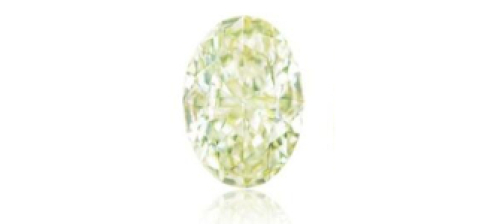 |
Although diamonds with colour grades from X to Z are still colourless diamonds, they already have a subtle, yet visible, coloured shimmer. They bring an excellent element of style and blend delicately and elegantly into any piece of jewellery. In addition, they offer a definite price advantage when compared to both completely colourless diamonds and those possessing a very distinct colour.
The colour grade Z marks the end of the official colour scale for colourless diamonds. From that point on, diamonds show a clearly recognisable colour and receive the prefix "Fancy".
Example: The diamond on the right shows a stronger and clearly visible yellow colour in comparison and is graded "Fancy Yellow".
|
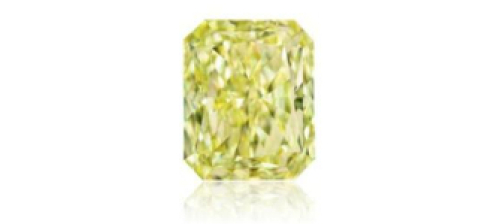 |
|
|
Pear Shape / GIA 6391398665
Fancy Deep Grayish Yellowish Green / 0.32 ct / VS1 / 5.48 x 3.83 x 2.31 mm
Oval / GIA 6224862126
Fancy Light Yellow Brown (C2) / 1.09 ct / VS1 / 8.08 x 5.59 x 3.51 mm
Radiant / GIA 2215524568
Fancy Deep Brownish Orange / 0.44 ct / I1 / 4.10 x 4.10 x 3.03 mm
Radiant / GIA 2376987490
Fancy Intense Yellow / 1.26 ct / VS1 / 5.73 x 5.67 x 3.91 mm
Round Brilliant / H&A-Cut
Top Light Brown / 1.03 ct / VS / 6.31 - 6.34 x 4.04 mm
Cushion / GIA 6217983902
Fancy Yellowish Brown (C2) / 4.02 ct / VVS1 / 8.95 x 8.44 x 6.09 mm
|
|
|
